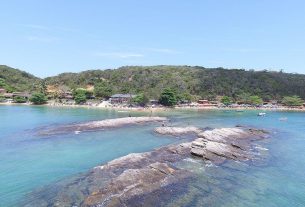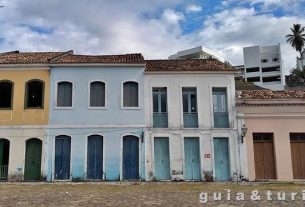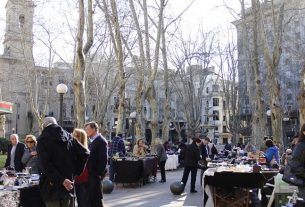More than harboring a paradisiacal setting, Rio de Janeiro has a strong cultural and artistic characteristic. Spread across the most varied corners and neighborhoods, there are museums, theaters, cultural centers, cathedrals and convents, libraries and former house of collectors. The tours are an enriching experience both cultural and architectural.
Theater Municipal
Inaugurated in 1909, this theatre is completely inspired by the Paris Opera. Exquisite, it has interior with arcades, columns, marble staircases, balustrades, sculptures and colorful stained glass from Europe. Paintings on the ceiling, the work of Elisei Visconti, surprise visitors as well as the images of 75 known figures. Recently retired in 2009. Guided tour is optional and requires prior booking. It is in the Floriano Square.
MAM Los Angeles
Architect Affonso Eduardo Reidy could not have been happier in his design. The modern museum is all dashed with straight lines. The landscape project of the renowned Burle Marx is not behind with wooded spaces and surrounded by lakes. The collection includes more than 11,000 works by national and international artists. Some temporary exhibitions also take place, to learn about check out the current schedule. The large space still reserves a bookstore, library, cafeteria, cinematheque, a gourmet restaurant and space for spiradic shows. It was opened in 1958 and is on Avenida Infante D. Henry.
Church of Our Lady of Gloria do Outeiro
One of the most charming churches in the city, the Outeiro was built in 1739 by the famous Valentine. It consists of panels with tiles inside and has the shape of an octagon when observed in the distance. In the back is guarded the Imperial Brotherhood Museum with objects of sacred origin. It is in Our Lady of Glory Square
the Fiscal Island
A former customs post until 1913, the site has a castle in the best neo-Gothic style. It houses a turret with side paintings on the walls, floor with mosaic in typical Brazilian woods, gleaming stained glass windows and columns, arches, flowers in cantaria. The place is remembered for having been the scene of the last dance of the Empire in 1889. The arrival is made through schooner and the tour lasts almost two hours. It is on Alfredo Agache Avenue.
Monastery of St. Benedict
The architectural beauty of the Monastery is on account of the Baroque Church Nossa Senhora de Monteserrat, from 1798 and has a gleaming gold coating, panels with sacred images of the 17th century and jacaranda furniture. On Sundays it is possible to participate in the ten-hour Mass with the exciting Gregorian songs of the monks. It is located at Rua Dom Gerardo.
the Pontifical House Museum
This museum values Brazilian popular art, there are more than five thousand pieces among works of Mestre Vitalino and objects of artisans from all over the country. The collection belongs to a French designer named Jacques van de Beuque, who dedicated 40 years of his life to collecting these pieces. For guided tours, prior scheduling is required. It is on Estrada do Pontal, 45 minutes from Copacabana.
The Imperial Palace
A former building and then headquarters of the Portuguese royal family in 1808, the Imperial Palace is full of stories to tell. Among the main events that occurred there are: Fico Day in 1922 when Prince Dom Pedro refused to return to Portugal, the signing of the Golden Law by Princess Isabel in 1888, among other events that took place in the Palace. Today it is a cultural space listed by IPHAN and brings together numerous attractions such as library, cinema, theater, exhibition hall, coffee shops, artisanal shops and restaurants. It is in the XV square.
Roberto Burle Marx website
Here lived for 21 years one of the greatest landscapers in history, Burle Marx with all his good taste could not have lived in a different place: the 365 thousand meters of the site are surrounded by 3,500 species of tropical plants. In the interior space is a chapel of 1681, greenhouses and an atelier with paintings, sculptures, antique furniture and crystals. It’s on the Burle Marx Road.
Cultural Center Parque das Ruínas
This cultural center is eclectic, it is the stage of varied performances of chorinho, theater for children, exhibitions and events and architectural admiration. The construction is structured in stone, wood and glass, giving a peculiar appearance to the place. The place was the residence of Rio de Janeiro patrons who organized saraus with the presence of Villa-Lobos and Isadora Duncan. From there, a beautiful view of Guanabara Bay should be appreciated. It is on Rua Murtinho Nobre.
Confectionery Colombo
This exquisite and ample space, has already received big names such as Chiquinha Gonzaga, Olavo Bilac and Rui Barbosa. Other bourgeois of the high society of the nineteenth centuries frequented the confectionery, opened in 1894. More than delight in the delicious recipes of savories and sweets that keep the secrets of the past, is to enjoy the architecture in art nouveau that recalls the belle epoque. They stand out: the Belgian crystal mirror, wooden notches, immense skylight and comfortable jacarandá chairs. It is located in Rua Gonçalves Dias.
Church of Our Lady of Candelaria
This church is famous for being the first in the city, erected in 1630. It has since been reformed several times until its last reform in 1898. Some ancient features remain as the façade and dome of lioz, typical Portuguese stone. The interior has neoclassical style and finished in marble. The colorful stained glass windows and sumptuous cast bronze doors are drawn. It is in Pius X Square.
Casa Daros
Situated in an old neoclassical mansion of 1886, the site has recently been renovated becoming modern and vintage at the same time. There, workshops, courses and lectures are organized. In addition, it is the scene of temporary exhibitions of contemporary artists from Latin America. Other attractions are: library, internal patio, palm garden, reading room, coffee and restaurant and shop. It is on General Severiano Street.
Museum of Art of Rio
No.: No., this museum was inaugurated in 2013, on the day that Rio celebrated its 448th anniversary. The birthday party could not be in best style, since this museum has 15,000 meters separated in environments with exhibitions, auditorium, recreational area, restaurant with panoramic views, coffee and shop. The exhibitions usually change and bring works by national and international artists. The space is divided into two interconnected buildings: Escola do Olhar and Palacete João VI. A suspended square and a covered ramp connect the environments. It is in Mauá Square.
the National Library
Dating back to 1910, it is considered the largest library in Latin America and the eighth in the world. Its collection of 13 million titles. In addition to the cultural experience, appreciate the architectural beauty of the building in art noveau and neoclassical style. It is recommended to make guided tours so as not to get lost in the literary world. The tour is 40 minutes long. It is on Avenida Rio Branco
Convent Santo Antonio
The complex was listed by IPHAN and brings together the convent itself, church of Santo Antônio and São Francisco da Penance. The church of San Francisco stands out by the walls of cedar covered with gold carvings that add up to 400 kilograms. There are found sculptures of Brazilian colonial art and some paintings. It is located in an 18th century building in Largo da Carioca.
Museum of the Republic
The former Catete Palace protects important stories such as the suicide of President Getúlio Vargas in 1954. It was the seat of the Presidency of the Republic from 1897 until 1960. It was transformed into a museum by President JK in the same year and today gained character of cultural space with exhibitions, cinema, theater, musical performances, exhibition of videos, bookshop and even shops and restaurants. The large surrounding gardens are used for hiking and, from time to time, some events. It is on Rua do Catete.
the National Museum
Located in the São Cristóvão Palace of 1892, this is the first museum in the country. It divides between the rooms: of archaeology with vases, mummies and coffins (all the heritage of Dom Pedro I); the Greco-Roman space that gathers belongings of Empress Teresa Cristina, wife of D. Pedro II; room of geology; zoology and ethnology. It is at Quinta da Boa Vista.
National Museum of Fine Arts
The museum includes a library with 15,000 publications between national and international works, peppers and sculptures from the 17th to the 20th centuries, medals, furniture and some images and objects that denote the African tradition. The museum has neoclassical features. It is on Avenida Rio Branco.
Instituto Moreira Salles
The familiar family Moreira Salles lived here. The modernist style is preserved. It is currently the stage of photographic exhibitions and musical center with a collection of CDs and biographies for consultation. In addition to these differentials, also houses cinema, library, auditorium, cafe, studio and gardens of Bule Marx. It is on Rua Marquês de São Vicente, in Gávea.
the National Historical Museum
Since 1922 the site has become a museum known for housing 250,000 pieces that aims to outline the history of Brazil going through remarkable moments such as the discovery of the Republic. They contribute to tell the facts: documents, paintings, photos, armaments, old banknotes and coins, furniture and carriage. Among the highlights is the Pátio dos Canhões, a room with pieces from the seventeenth to the 20th centuries. It also has a charming cafeteria. Access with escalators and elevator brought accessibility to the museum. It is in the Marechal Anchor Square.
Portuguese Library
This traditional Portuguese library brings together a collection of 350,000 Portuguese books, the largest Portuguese literary ensemble outside Portugal. From 1887, it has Manueline style facade and sculptures of historical people. The architectural charm of the environment is due to the skylight and wooden shelves with notches. It is located in Rua Luís de Camões.
France-Brazil House
The architect Grandjean de Montigni gave birth to this building of 1820 with neoclassical facade, round windows and roofs with elevations. The interior houses cinema, temporary exhibitions, events, bistro and shop of handmade products. It is located on Rua Visconde de Itaboraí.
the Metropolitan Cathedral
The grandeint of the building is the first surprise of any tourist. To give you an idea, it is 75 meters high and 106 meters in diameter of a cathedral with eccentric cone shape. It has capacity for up to 20,000 people standing. Besides the outside, the interior also exudes architectural beauties as a huge image of Christ suspended and the stained glass windows. The Museum of Sacred Art is in the basement of the cathedral with interesting objects such as D’s throne. Pedro II, christening sink of the Royal Family, paintings, sculptures, furniture, noble porcelain, silverware and jewels of past decades. It is located on Avenida Republic of Chile.
the Banco do Brasil Cultural Center
Former bank until 1989, it was transformed into a Cultural Center that includes a library with 140,000 copies of books, space for exhibitions, cinema, bookstore, theater, shop, restaurants and tea room for a delicious afternoon tea with everything that is right. It is on Rua First of March.
the Federal Justice Cultural Center
Recently retired, the space was once the seat of the Supreme Federal Court between 1909 and 1960. There are often photographic exhibitions and some paintings that value the national production. It is on Avenida Rio Branco.
Cultural Space of the Navy
This is an interesting space for fans of the Brazilian Navy. The site recounts stories through maps, models and old equipment used in boats. Throughout the tour are scrap boxes found on the Brazilian coast and a rowing vessel dating from 1808. A pier guards a helicopter and a huge submarine. Space is a thousand meters. It is on Alfredo Agache Avenue.
The Fort of Copacabana
The years since the construction of the fort in 1914 have not erased the original traits. They are incredible walls of 12 meters high and German cannons of the 20th century. From there, you can see a beautiful seascape from Copacabana. The interior includes the Army Historical Museum with explanatory panels and weaponry. It is in Colonel Eugênio Franco Square.
The night tour
The Institute of Geography of the Federal University of Rio de Janeiro organizes in partnership with the Municipal Secretariat of Culture interesting night tours since 2010. The goal is to take tourists to alternative itineraries that escape a little of the traditional tours and the urban buzz. The program includes hiking, tram rides through buildings, squares and ancient monuments. Some stops happen to satisfy the curiosity of visitors. Along the way, guides play their role and tell stories with rich details.
Museum of the Sky Farm
The house, of modern design, brings together eight thousand pieces of art of modernity. The site is the former residence of the collector named Raymundo Castro Maia. There are paintings of Volpy and Di Cavalcanti, watercolors of Debret and sketches of Don Quixote drawn by Portinari. From there you can enjoy a panoramic view that covers Guanabara Bay and the Center. It is on Rua Murtinho Nobre.
the Palace of Laranjeiras
The palace belonging to the Guinle family became the residence of the governors in 1975. Thus, it is not allowed the free transition by all environments, only to the social wing with paintings, sculptures, furniture and other objects brought from Europe. It is on Rua Paulo Cesar de Andrade.
The Museum of Açude
The colonial mansion of 1913 reserves beauties both externally and internally. For starters, the house is in an area of 150,000 meters in the Tijuca Forest. The green area is intense, with varied trails and gardens with contemporary sculptures. The numerous panels of imported tiles from other countries, dating from the 18th to the 19th century, contribute to the external beauty. Chinese and Indian culture is observed inside, with porcelain and sculptures, as well as French crystals and English silverware. Here, it is the summer house of Raymundo de Castro Maya. It is on the Açude Road.
Brazilian Academy of Letters
The academy took inspiration from the Petit Trianon in Paris in 1922. Perfection is explained by the French government itself having erected the place. There are 90,000 books available in the library collection, furniture of national writers, bookstore, coffee and a space dedicated to the master Machado de Assis in the annex, with objects that belonged to him. It is on Avenida Presidente Wilson.
the Post Office Cultural Center
Here the post office worked for 50 years. It was decommissioned in the 1980s and has been transformed into a cultural center since its inauguration in 1993. The space gives way to art galleries, exhibitions, theater, bistro and cinema. The building has three floors and is next to the Post Office Square with a mirror of the water embellishing the environment. It is located on Rua Visconde de Itaboraí, in the Center.
The First Reign Museum
This neoclassical-style solar was built by D. Pedro I to become the residence of his mistress Domitila de Castro Canto e Melo, who lived there for three years. There are panels and documents that tell the story of the First Reign and murals in low relief. It is on Avenida Pedro II.
Museum of Justice of Rio
For those interested in the history of the Rio de Janeiro Judiciary, it is worth the visit at the old Palace of Justice. The guided one-hour tour leads to the Noble Hall, Hall of Mirrors, Library, Plenary of the Court of the Old Court, Chamber Sessions Room, the Hall of Lost Steps, the Jury Court, Library of Rare Works, Exhibition Rooms of Judiciary Environment, Forensic Furniture and Legal-Pedagogical Workshop. During the journey, the guides talk about the importance of each room. It is on Dom Manuel Street.
the Eva Klabin Foundation
The foundation brings together works by collector Eva Klabin who lived in the house and collected pieces for 70 years. The collection is eclectic with two thousand works from the most different locations. Organized by theme, such as the Egyptian, Chinese and Greek wing it is possible to observe sculptures and paintings, silverware, carpets and rustic furniture. The visits are guided. It is on Avenida Epitácio Pessoa.
International Museum of Naif Art of Brazil
The old 19th century mansion has the richest collection in the country. In all, there are six thousand pieces by artists from 130 countries, highlighting the peculiarity of each nation through irregular traits and portraying bucolic themes. It is in the Old Cosme Street.





